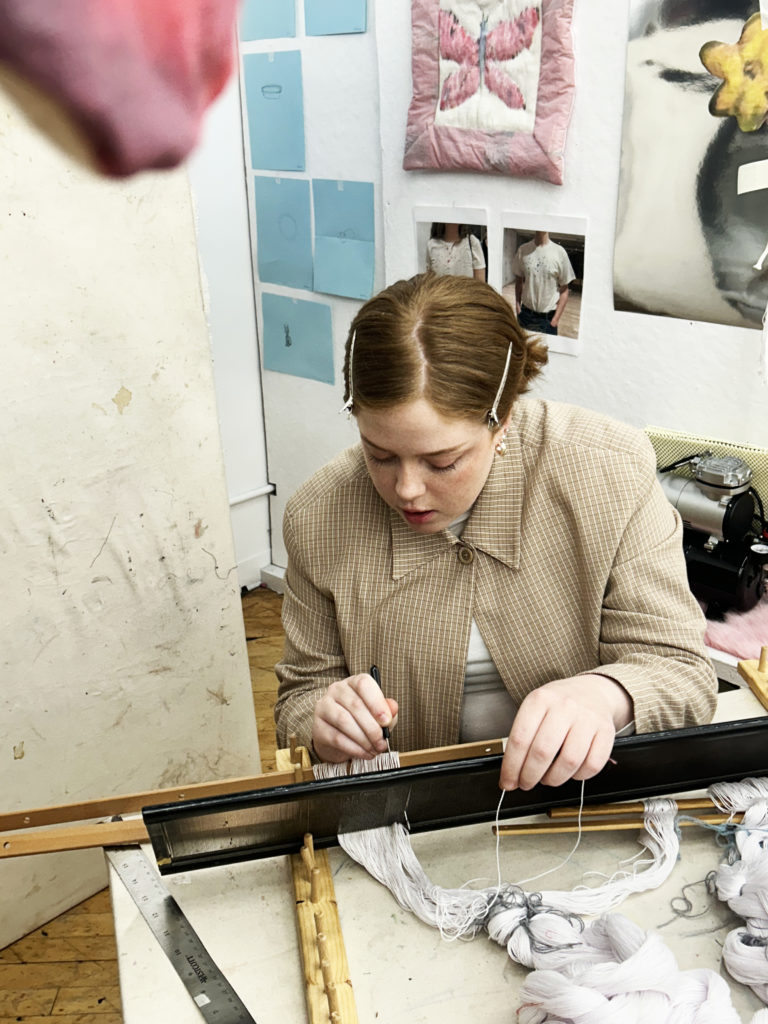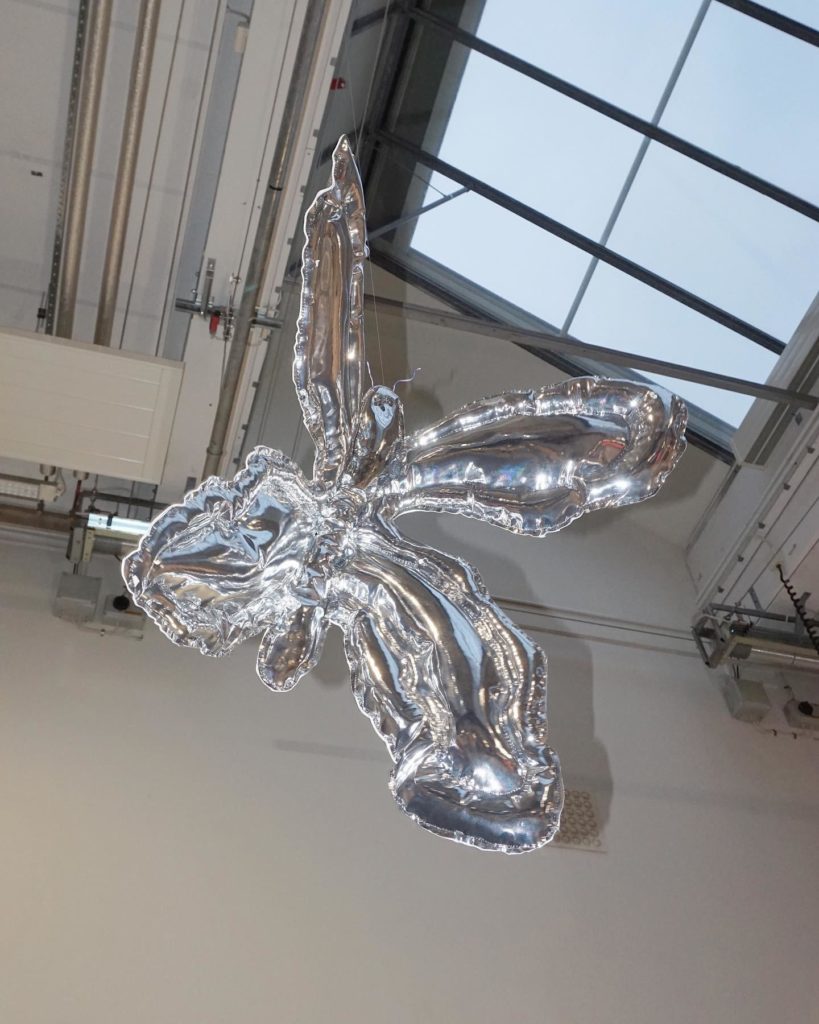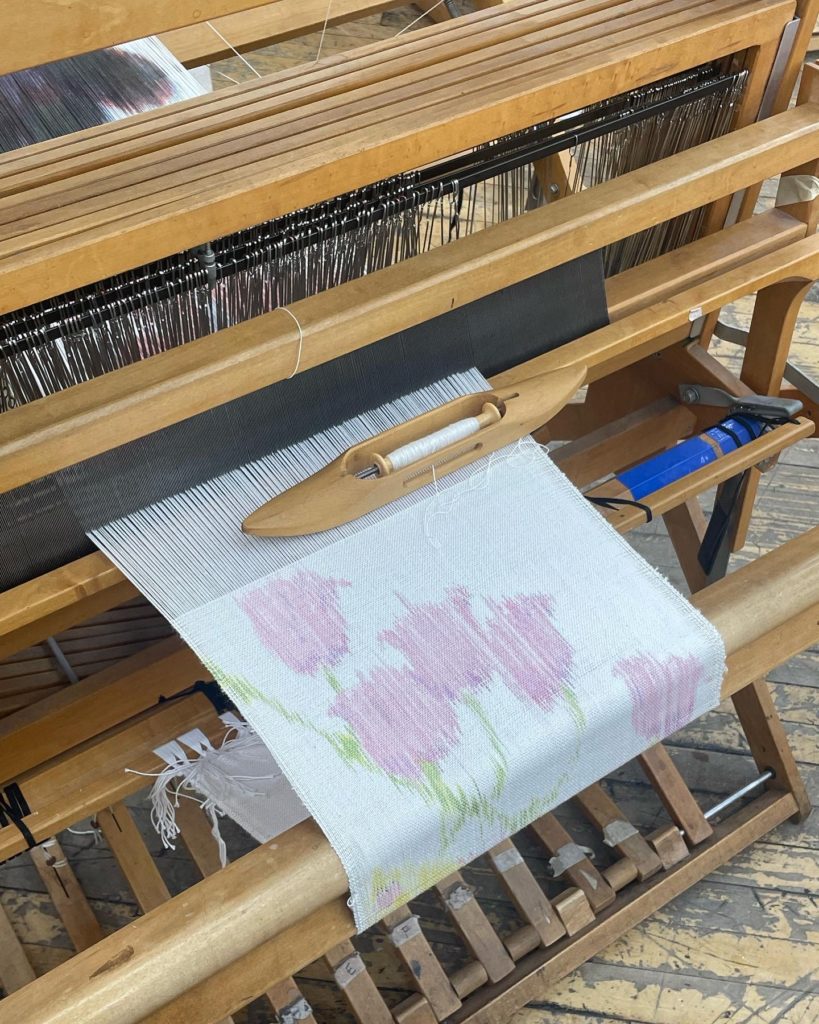AIR 15 Feature: Lovisa Axén
Sahana Srinivasan, our Artist Programs intern, got together with current AIR 15 resident Lovisa Axén (b. 1996, Götlunda/Sweden).
Sahana: I can see you just got back from the fabric store
Lovisa: Yeah, I got some interfacing, some cute lace, so I could start making some quilted frames. That’s my haul for the moment!

"I started with quilting and painting, and within that, I was really interested in the three dimensional space. But with weaving, I wanted to see how I can control the distortion when I paint on the work. I think the distortion also plays into a theme I’m looking at, which is the shadow self."
S: Have you worked on quilted frames before?
L: Yeah, I made some before to make my textile pieces shift into the wall art sphere. But now, I want to make them flatter so that the piece itself looks like it just comes up from the frame.
S: So with your frames in mind, I know that you’ve been working a lot with fabric ink and with weaving during this play period. Can you tell me more about that?
L: Yeah! During my education I worked with textiles separately and painting separately, so now I’m seeing how they can intersect with each other. So I’ve been trying to explore with reactive dyes, some natural dyes on unbleached cotton. And then I’ve been trying to paint on warp threads, as well as trying to airbrush pictures on the warp as well.
S: What kind of got you started with intersecting painting and weaving in particular?
L: I started with quilting and painting, and within that, I was really interested in the three dimensional space. But with weaving, I wanted to see how I can control the distortion when I paint on the work. I think the distortion also plays into a theme I’m looking at, which is the shadow self.
S: How long have you been thinking about the shadow self as a concept in your art?
L: I think it’s been lurking around in my work for a while, but when I condense it, my work deals with reflection and connections between the inner and outer selves. But there’s a sense of humor that comes along with it as well. I think I started thinking about common objects when coming into TAC, and that flows on its own into the shadow self. I’ve been looking at mirrors or photobooths, within my drawings, so I think that goes from common objects into this shadow self realm.

Detail of "Sometimes I Miss The Outdoors"
Textile print, freehand embroidery on polyester filling.
S: Are there any certain films, documentaries, artworks, or music influencing your themes right now?
L: Documentaries, and more documentaries, particularly from other artists, to see what their process is like. But I’ve been watching the Moomin animations!
S: The ones by Tove Jansson?
L: Yeah, the little books that she made, which then made into a series. It’s so cute! But the illustrations are so adorable, but it’s talking about heavy subjects at the same time. I think the first book is about how the world is going to end because of a shooting star.
S: Wait, that's a little scary.
L: Yeah I think that’s why I gravitate towards it, because it’s so cute but also a bit unnerving. Especially when we grew up watching these animations and reading the books when we’re in kindergarten. But I look at emulating that unnerving cuteness in my work as well, like with the flowers that I painted with the fabric dye. They feel delicate and pretty on the surface, but they also have a ghost-like or shadow-like quality with them when someone looks closer. They also look like they’re bleeding.
S: They really, especially around the edges.
L: But I haven’t condensed on a theme, like if you asked me a month ago, I wouldn’t have a concrete answer in terms of concept.
S: So what’s shifted around in the play period, then?
L: I got a lot of time during this period, to watch more documentaries or videos that I feel inspire me conceptually, explore techniques, and dive into my past works, in terms of seeing what I want to do next.
S: When you talk about your past work, do you see a certain dialogue that occurs between what you’re doing now and what you did in the past?
L: For me, it was more the cultural circumstances that impacted the way I look at my practice. There are more social differences between here and Sweden, and on top of that, I feel a lot more developed in my practice compared to my time in art school. I feel like compared to my past work, I’m looking at the basics a lot more, now that I’m here and I have that focus in the play period. I think I’ve also seen a shift in my color choices now, compared to the past. I don’t think I’m really picking out certain colors just because they look nice, I feel like I’m actually trying to do the opposite. But we’ll see where that goes as well.
S: Another thing to note about your work in particular is the use of delicate imagery, like the flowers, butterflies, small insects. What is your own perspective on creating contrast with the soft nature of the imagery?

L: That’s another thing I’m still figuring out, the contrast and how that comes off. I’ve been really interested in insects recently, especially mosquitos.
S: Mosquitos?
L: Yeah I think they’re just silly little creatures, and everybody hates them, but I think they’re so cute!

S: You might be the first person to say that.
L: Yeah, I remember seeing a big sculpture rendition of one at the Natural History Museum, and they’re just gross and cute at the same time!
"Textiles in some way makes things softer and approachable. Even in a museum space, a textile piece always has a sign next to it that says “Please do not touch”, because our natural inclination is to touch it. But I find it to be a more approachable medium, in terms of viewing. It’s a lot kinder. So, I find playing around with texture goes after that unnerving and pretty intersection. Even when weaving now, I’m trying to make my pieces a lot more stiff and a lot more packed in."
S: When you’re saying something is gross and cute, or even earlier you mentioned somethings being unnerving and pretty at the same time, how does that intersection translate in textiles?
L: Textiles in some way makes things softer and approachable. Even in a museum space, a textile piece always has a sign next to it that says “Please do not touch”, because our natural inclination is to touch it. But I find it to be a more approachable medium, in terms of viewing. It’s a lot kinder. So, I find playing around with texture goes after that unnerving and pretty intersection. Even when weaving now, I’m trying to make my pieces a lot more stiff and a lot more packed in.
S: Yeah with this weave in particular, it looks so different on the wall compared to when I feel it.

L: It also comes with the curiosity to manipulate the fabric that I’m working with. I like the idea that if someone sees my work, they wouldn’t immediately recognize the materiality.
S: It goes for the butterfly sculpture that you have as well.
L: Yeah, a lot of people think that it’s a balloon at first glance, but it’s a soft sculpture. So I like playing around with that kind of manipulation as well. But looking at these different ways of materiality, textures, and concepts are much more free flowing after this play period.
S: It’s been a fun play period to see the directions that have been taken. What’s your sum up of it?
L: I think it’s explorative, as I said, but also combined with moving to New York, it’s been very slow in terms of finding my own footing in the city.
S: Are there exhibits that you’ve seen here that have inspired you recently?
L: Yes! I saw this audio-visual exhibit at the Noguchi Museum which was incredible, as well as the Natural History Museum. I like my mosquitoes.
S: You like your mosquitoes indeed! But as we end, what are you thinking about working on next?
L: I’m going to keep painting on the warp, as well as starting to airbrush on the warp. And of course, I’m going to try to condense and shape my theme. But I’ll keep listening to Tove Jansson’s stories for the moment.